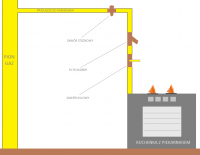Hello, I intend to replace the damaged gas valve next to the stove in the near future. So I have a question about sealing threaded connections - namely which solution do you think provides the best ? connection?
best:
- the most sealed,
- resistant to temperature changes,
- non-corrosive,
- non-annoying,
- not working with the material,
- non-toxic,
- easy to crank up after years, etc.
I have read a little about this topic and I prefer to deal with it, because how many experts have so many opinions.
I will add the solutions that I found:
- use of linen flax using Unipak paste
- use of linen flax with the use of Multipak paste
- use of linen flax with LT-43 grease
- use of linen flax with graphite grease
- use of flax rolls using Loctite adhesive
- using only Loctite adhesive
- use of teflon tape
- use of teflon thread / thread
- use of a towot
- use of phthalic paint
- use of linen varnish
- use of minia
- use of gaskets / O-rings
There is still the issue of creeping / cutting the external thread, some write to cut others against it, and using perfectly tight connectors. There are a lot of solutions, I am asking for advice which apply. I know that "many roads lead to Rome" and each of the solutions has its advantages and disadvantages, but nevertheless I care about choosing the best. The most important thing is the fact that I am talking about a gas installation, which, as we know, differs slightly with other laws than, for example, water.
greetings
Ps. The topic turned out to be very helpful: https://www.elektroda.pl/rtvforum/topic2039015.html
best:
- the most sealed,
- resistant to temperature changes,
- non-corrosive,
- non-annoying,
- not working with the material,
- non-toxic,
- easy to crank up after years, etc.
I have read a little about this topic and I prefer to deal with it, because how many experts have so many opinions.
I will add the solutions that I found:
- use of linen flax using Unipak paste
- use of linen flax with the use of Multipak paste
- use of linen flax with LT-43 grease
- use of linen flax with graphite grease
- use of flax rolls using Loctite adhesive
- using only Loctite adhesive
- use of teflon tape
- use of teflon thread / thread
- use of a towot
- use of phthalic paint
- use of linen varnish
- use of minia
- use of gaskets / O-rings
There is still the issue of creeping / cutting the external thread, some write to cut others against it, and using perfectly tight connectors. There are a lot of solutions, I am asking for advice which apply. I know that "many roads lead to Rome" and each of the solutions has its advantages and disadvantages, but nevertheless I care about choosing the best. The most important thing is the fact that I am talking about a gas installation, which, as we know, differs slightly with other laws than, for example, water.
greetings
Ps. The topic turned out to be very helpful: https://www.elektroda.pl/rtvforum/topic2039015.html




